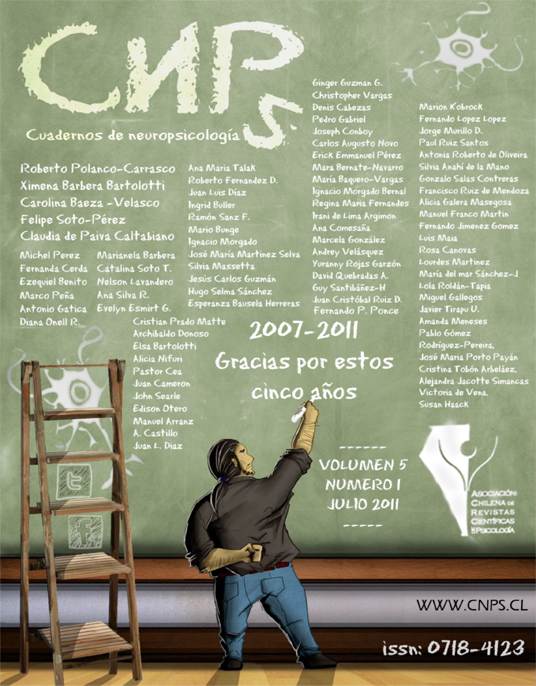Validez de la conexión interlexica asemántica en el modelo cognitivo de procesamiento de Praxias. Validity of the Connection Inter-lexical a-semantics in the cognitive model of processing praxis.
Abstract
Resumen
González Rothi et al. (1991, 1997) postularon un modelo cognitivo de praxias, sobre el que fueron propuestas modificaciones (Cubelli et al., 2000), entre ellas la supresión de la vÃa directa entre el praxicón de entrada y el praxicón de salida. Se planteó que para validar una vÃa interlexica asemántica (Cubelli et al., 2000), serÃa suficiente el hallazgo de un paciente con habilidad conservada de imitar gestos familiares, pero con alteraciones en la capacidad de acceder al significado de gestos familiares y alteraciones en la habilidad de imitar gestos no familiares. El objetivo de este trabajo es presentar dos pacientes cuyos patrones de rendimiento práxico apoyan la existencia de una vÃa interlexical asemántica. Se evaluó a 2 pacientes con diagnóstico de demencia tipo Alzheimer probable con una baterÃa de evaluación cognitiva de apraxias (Politis 2003). Ambos pacientes evidencian alteraciones en la prueba de imitación de gestos no familiares y en las tareas que evalúan semántica de la acción (apareamiento objeto-herramienta y denominación por función), con buen rendimiento en la tarea de la imitación de gestos familiares. Tomando como base los modelos cognitivos de praxias de González Rothi et al. (1991, 1997) y Cubelli et al. (2000) es necesaria una conexión directa entre el praxicón de entrada y el praxicón de salida para explicar el rendimiento de estos pacientes. De este modo, el patrón de rendimiento que muestran ambos pacientes confirmarÃa la existencia de una vÃa interléxica asemántica.
Palabras Clave: Alzheimer; Apraxia, imitación gestual, lesión cerebral, vÃa interlexica asemántica.
Abstract
Rothia Gonzalez et al. (1991, 1997) postulated a cognitive model of praxis on which changes were proposed (Cubelli et al., 2000), including the removal of the direct path between both input praxicon and output. Was suggested that to validate an inter-lexical a-semantics path (Cubelli et al., 2000) would enough to find a patient with preserved ability for imitate familiar gestures, but with disturbances in the ability to access to the meaning of familiar gestures and alterations in ability for imitate unfamiliar gestures. The aim of this work is present two patients whose patterns of performance on praxis supports the existence of a pathway inter-lexical a-semantic. We evaluated two patients with Alzheimer type dementia unlikely with a battery of cognitive assessment of apraxia (Politis 2003). Both patients show alterations in test of Imitation of unfamiliar gestures and on tasks which assess semantic action (object-tool matching and naming by function), with good performance on the task of imitating familiar gestures. Based on cognitive models of praxis Rothia Gonzalez et al. (1991, 1997) and Cubelli et al. (2000) is require a direct connection between both input praxicon and output to explain the performance of these patients. Of thus, the performance pattern showing both patients confirms existence of a pathway. Interlexical asemantics.
Keywords: Alzheimer; Apraxia, imitate gestures; brain injury; Interlexical Asemantics.
Downloads
Published
How to Cite
Issue
Section
License
Articles published in this journal are protected under the Creative Commons Attribution-NonCommercial-ShareAlike 4.0 International (CC BY-NC-SA 4.0) license. This means that authors retain full rights over their research and publications at all times. As a journal, we fully respect and promote the principles of open access established by this license, allowing the work to be shared, adapted, and distributed for non-commercial purposes, provided that appropriate credit is given to the authors and any derivative works are licensed under the same terms.
Authors are responsible for obtaining the required permission when they wish to reproduce part of the material (figures, etc.) from other publications.
Likewise, CNPs allows authors to host in their personal sites or other repositories that they deem convenient the Final and Definitive Version of the published article with the format assigned by the journal. In no case do we allow access to preprints of the article under evaluation or already published.
When submitting an article to CNPs you are aware that all the contents of CNPs are under a Creative Commons License. In which it is allowed to copy and share the contents freely, always making reference to the origin of the publication and its author.





